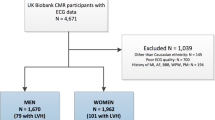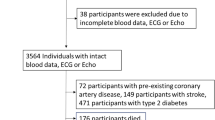Abstract
The clinical usefulness of the Sokolow–Lyon voltage criteria in the assessment of electrocardiographic left ventricular hypertrophy (ECG LVH) is addressed. We prospectively studied 3338 women and 3330 men referred with hypertension, with an average follow-up of 11.2 years. The voltage amplitude sum SV1+max (RV5 or RV6) was calculated and ECG LVH was defined as a sum ⩾3.5 mV. We adjusted survival for age, treatment status before presentation and a previous myocardial infarction or cerebrovascular accident. The risk of stroke, coronary heart disease (CHD) and cardiovascular disease (CVD) mortality increased significantly for each quantitative 0.1 mV increase in baseline electrocardiogram (ECG) voltage, in women within the range of 1.6–3.9% and in men 1.4–3.0%. After further adjustments for race, body mass index, smoking and systolic blood pressure, increasing voltage independently predicted CVD mortality in both men and women. In women, both increasing voltage and the presence of left ventricular hypertrophy (LVH) were predictors of stroke mortality, whereas in men this risk was attenuated. In men, the adjusted association between increasing voltage and CHD mortality tended to be stronger than in women. The use of different thresholds for the two genders made little difference. For stroke and CHD mortality, the population attributable fractions associated with LVH were 15.2 and 5.4% in women and 12.8 and 8.5% in men, respectively. In conclusion, the greater the baseline ECG voltage sum, the greater the associated CVD mortality risk. Women tended to have a high risk of stroke mortality owing to LVH despite adjustments.
This is a preview of subscription content, access via your institution
Access options
Subscribe to this journal
Receive 12 digital issues and online access to articles
$119.00 per year
only $9.92 per issue
Buy this article
- Purchase on Springer Link
- Instant access to full article PDF
Prices may be subject to local taxes which are calculated during checkout
Similar content being viewed by others
References
2003 European Society of Hypertension-European Society of Cardiology. Guidelines for the management of arterial hypertension. J Hypertens 2003; 21: 1011–1053.
Kannel WB . Left ventricular hypertrophy as a risk factor: the Framingham experience. J Hypertens 1991; 9 (Suppl 2): S3–S9.
Kahan T . The importance of left ventricular hypertrophy in human hypertension. J Hypertens 1998; 16 (Suppl 8): S23–S29.
Bots ML, Nikitin Y, Salonen JT, Elwood PC, Malyutina S, Freire de Concalves A et al. Left ventricular hypertrophy and the risk of fatal and non-fatal stroke. EUROSTROKE: a collaborative study among research centres in Europe. J Epidemiol Commun Health 2002; 56 (Suppl I): i8–i13.
De Bacquer D, De Backer G, Kornitzer M, Blackburn H . Prognostic value of ECG findings for total, cardiovascular disease, and coronary heart disease death in men and women. Heart 1998; 80: 570–577.
Kahn S, Frishman WH, Weissmann S, Ooi WL, Aronson M . Left ventricular hypertrophy on electrocardiogram: prognostic implications from a 10-year cohort study of older subjects. A report from the Bronx Longitudinal Ageing Study. J Am Geriatr Soc 1996; 44: 524–529.
Brown DW, Giles WH, Croft JB . Left ventricular hypertrophy as a predictor of coronary heart disease mortality and the effect of hypertension. Am Heart J 2000; 140: 848–856.
MacMahon S, Collins G, Rautaharju P, Cutler J, Neaton J, Prineas R, et al. for the Multiple Risk Factor Intervention Trial Research Group. Electrocardiographic left ventricular hypertrophy and effects of antihypertensive drug therapy in hypertensive participants in the Multiple Risk Factor Intervention Trial. Am J Cardiol 1989; 63: 202–210.
Dunn FG, McLenachan J, Isles CG, Brown I, Dargie HJ, Lever AF et al. Left ventricular hypertrophy and mortality in hypertension: an analysis of data from the Glasgow Blood Pressure Clinic. J Hypertens 1990; 8: 775–782.
Verdeccia P, Schillaci G, Borgioni C, Ciucci A, Gattobigio R, Zampi I et al. Prognostic value of new electrocardiographic method for diagnosis of left ventricular hypertrophy in essential hypertension. J Am Coll Cardiol 1998; 31: 383–390.
Sundström J, Lind L, Ärnlöv J, Zethelius B, Andrén B, Lithell HO . Echocardiographic and electrocardiographic diagnoses of left ventricular hypertrophy predict mortality independently of each other in a population of elderly men. Circulation 2001; 103: 2346–2351.
Levy D, Garrison R J, Savage DD, Kannel WB, Castelli WP . Prognostic implications of echocardiographically determined left ventricular mass in Framingham Heart Study. N Engl J Med 1990; 322: 1561–1566.
Koren MJ, Devereux RB, Casale PN, Savage DD, Laragh JH . Relation of left ventricular mass and geometry to morbidity and mortality in uncomplicated essential hypertension. Ann Int Med 1991; 114: 345–352.
Devereux RB, Koren MJ, de Simone Okin PM, Kligfield P . Methods for detection of left ventricular hypertrophy: application to hypertensive heart disease. Eur Heart J 1993; 14 (Suppl D): 8–15.
Gardin JM, Siscovick D, Anton-Culver H, Lynch JC, Smith VE, Klopfenstein HS et al. Sex, age, and disease affect echocardiographic left ventricular mass and systolic function in the free-living elderly. The Cardiovascular Health Study. Circulation 1995; 91: 1739–1748.
Sokolow M, Lyon TP . The ventricular complex in left ventricular hypertrophy as obtained by unipolar precordial and limbs leads. Am Heart J 1949; 37: 161–186.
Abergel E, Tase M, Menard J, Chatellier G . Influence of obesity on the diagnostic value of electrocardiographic criteria for detecting left ventricular hypertrophy. Am J Cardiol 1996; 77: 739–744.
Bulpitt CJ, Beillin LJ, Coles EC, Dollery CT, Johnson BF, Munro-Faure AD et al. Randomised controlled trial of computer-held medical records in hypertensive patients. BMJ 1976; 1: 677–679.
Beilin LJ, Bulpitt CJ, Coles EC, Dollery CT, Johnson BF, Mearns C et al. Computer-based hypertension clinic records: a co-operative study. BMJ 1974; 2: 212–216.
Cox DR . Regression models and life tables. J R Stat Soc (B) 1972; 34: 187–220.
Kannel WB, Gordon T, Castelli W, Margolis JR . Electrocardiographic left ventricular hypertrophy and risk of coronary heart disease. Framingham Study. Ann Int Med 1972; 72: 813–822.
Tanne D, Yaari S, Goldbourt U . Risk profile and prediction of long-tern ischemic stroke mortality. A 21-year follow-up in the Israeli Ischemic Heart Disease (IIHD) Project. Circulation 1998; 98: 1365–1371.
Fagard RH, Staessen JA, Thijs L, Celis H, Birkenhäger WH, Bulpitt CJ, et al. for the Systolic Hypertension in Europe (Syst-Eur) Trial Investigators. Prognostic significance of electrocardiographic voltages and their serial changes in elderly with systolic hypertension. Hypertension 2004; 44: 459–464.
Van Hoof R, for the members of European Working Party on High Blood Pressure in the Elderly. Left ventricular hypertrophy in elderly hypertensive patients: a report from the European Working Party on High Blood Pressure in the Elderly Trial. Am J Med 1991; 90 (Suppl 3A): 55S–59S.
Lanti M, Puddu PE, Menotti A . Voltage criteria of left ventricular hypertrophy in sudden and nonsudden coronary artery disease mortality: the Italian Section of the Seven Countries Study. Am J Cardiol 1990; 66: 1181–1185.
Hsieh BP, Pham MX, Froelicher VF . Prognostic value of Electrocardiographic criteria for left ventricular hypertrophy. Am Heart J 2005; 150: 161–167.
Kannel WB, Wolf PA, Benjamin EJ, Levy D . Prevalence, incidence, prognosis, and predisposing conditions for atrial fibrillation: population based estimates. Am J Cardiol 1998; 82: 2N–9N.
Liao Y Cooper RS, Mensah GA, McGee DL . Left ventricular hypertrophy has a greater impact on survival in women than in men. Circulation 1995; 92: 805–810.
Report of the Joint National Committee on Detection, Evaluation, and Treatment of High Blood Pressure. A cooperative study. JAMA 1977; 237: 255–262.
Levy D, Anderson KM, Savage DD, Kannel WB, Christiansen JC, Castelli WP et al. Echocardiographically detected left ventricular hypertrophy: prevalence and risk factors. The Framingham Heart Study. Ann Int Med 1988; 108: 7–13.
Levy D, Labib SB, Anderson KM, Christiansen JC, Kannel WB, Castelli WP . Determinants of sensitivity and specificity of electrocardiographic criteria for left ventricular hypertrophy. Circulation 1990; 81: 815–820.
Alfakih K, Walters K, Jones T, Ridgway J, Hall AS, Sivananthan M . New gender-specific partition values for ECG criteria of left ventricular hypertrophy. Recalibration against cardiac MRI. Hypertension 2004; 44: 175–179.
Palmieri V, Bella JN, Arnett DK, Liu JE, Oberman A, Schuck MY et al. Effect of type 2 diabetes mellitus on left ventricular hypertrophy geometry and systolic function in hypertensive subjects. Hypertension Genetic Epidemiology Network (HyperGEN) Study. Circulation 2001; 103: 102–107.
Devereux RB, Roman MJ, Paranicas M, O’Grady MJ, Lee ET, Welty TK et al. Impact of diabetes on cardiac structure and function. The Strong Heart Study. Circulation 2000; 101: 2271–2276.
Antikainen R, Grodzicki T, Palmer AJ, Beevers GD, Coles EC, Webster J . Determinants of left ventricular hypertrophy defined by Sokolow–Lyon criteria. J Hum Hypertens 2003; 17: 159–164.
Rutter MK, Parise H, Benjamin EJ, Levy D, Larson MG, Meigs JB et al. Impact of glucose intolerance and insulin resistance on cardiac structure and function. Sex-related differences in the Framingham Heart Study. Circulation 2003; 107: 448–454.
Levy D, Salomon M, D’Agostino RB, Belanger AJ, Kannel WB . Prognostic implications of baseline electrocardiographic features and their serial changes in subjects with left ventricular hypertrophy. Circulation 1994; 90: 1786–1793.
Hypertension Detection and Follow-up Program cooperative group. Five years findings of Hypertension detection and follow-up program. Prevention and reversal of left ventricular hypertrophy with antihypertensive treatment. Hypertension 1985; 7: 105–112.
Dahlöf B, Devereux RB, Kjeldsen SE, Julius S, Beevers G, de Faire U et al. Cardiovascular morbidity and mortality in the Losartan Intervention for Endpoint reduction in hypertension study (LIFE): a randomised trial against atenolol. Lancet 2002; 359: 995–1003.
Mathew J, Sleight P, Lonn E, Johnstone D, Pogue J, Yi Q, et al. for the Heart Outcomes Prevention Evaluation (HOPE) Investigators. Reduction of cardiovascular risk by regression of electrocardiographic markers of left ventricular hypertrophy by angiotensin converting enzyme inhibitor ramipril. Circulation 2001; 104: 1615–1621.
Okin PM, Devereux RB, Jern S, Kjeldsen SE, Julius S, Nieminen MS, et al. for the LIFE Study investigators. Regression of electrocardiographic left ventricular hypertrophy during antihypertensive treatment and the prediction of major cardiovascular events. JAMA 2004; 292: 2343–2349.
Prineas RJ, Rautaharju P, Grandits G, Crow R for the MRFIT Research Group. Independent risk for cardiovascular disease predicted by modified continuous score electrocardiographic criteria for 6-year incidence and regression of left ventricular hypertrophy among clinically disease free men: 16-year follow-up for the Multiple Risk Factor Intervention Trial. J Electrocardiol 2001; 34: 91–101.
Acknowledgements
This study was supported by grants from the Finnish Medical Foundation and the UK Department of Health and Social Security. The following also participated in the DHSS: Beilin LJ, Cohen A, Coles EC, Dollery CT, Fletcher AE, Jeffers TA, Ledingham JGG, Munro-Faure AD, Petrie JC, Robb OJ, Rossiter C, Rylance PB, Struthers A. From general practice: Davies JB, Douglas-Jones AP, Grant D, Horder E, Kenworthy-Browne JM.
Author information
Authors and Affiliations
Consortia
Corresponding author
Rights and permissions
About this article
Cite this article
Antikainen, R., Grodzicki, T., Palmer, A. et al. Left ventricular hypertrophy determined by Sokolow–Lyon criteria: a different predictor in women than in men?. J Hum Hypertens 20, 451–459 (2006). https://doi.org/10.1038/sj.jhh.1002006
Received:
Revised:
Accepted:
Published:
Issue Date:
DOI: https://doi.org/10.1038/sj.jhh.1002006
Keywords
This article is cited by
-
Electrocardiographic-left ventricular hypertrophy and incident stroke among Chinese hypertensive adults
Journal of Human Hypertension (2020)
-
Modes of death and clinical outcomes in adult patients with hypertrophic cardiomyopathy in Thailand
BMC Cardiovascular Disorders (2019)
-
Left ventricular hypertrophy by Sokolow-Lyon voltage criterion predicts mortality in overweight hypertensive subjects
Journal of Human Hypertension (2009)
-
The prognostic value of the ECG in hypertension: where are we now?
Journal of Human Hypertension (2008)



